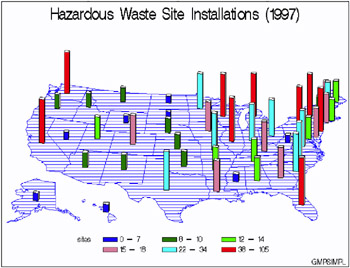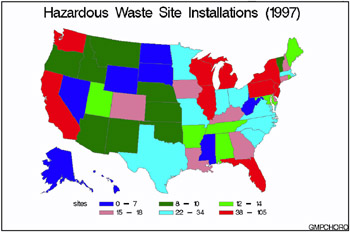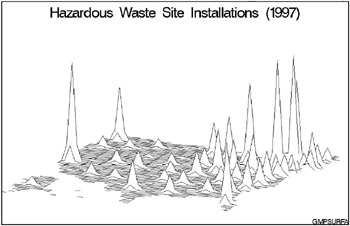Chapter 35: The GMAP Procedure
Overview
The GMAP procedure produces two-dimensional ( choropleth ) or three-dimensional (block, prism, and surface) color maps that show variations of a variable value with respect to an area. A wide assortment of map data sets are available with SAS/GRAPH software.
Use the GMAP procedure to
-
produce maps
-
summarize data that vary by physical area
-
show trends and variations of data between geographic areas
-
highlight regional differences or extremes.
About Block Maps
Block maps display a block at the approximate center of each map area to convey information about response variable values. The height of each block represents a response level. The height is not directly proportional to the value of the response variable. Instead, the block heights increase in order of the response levels.
Figure 35.1 on page 997 shows a simple block map of hazardous waste sites that are installed in each state. The number of sites in each state (the response value) is represented by the height of the block.

Figure 35.1: Block Map
The program for this map is in Example 1 on page 1045. For more information on producing block maps, see BLOCK Statement on page 1009.
About Choropleth Maps
Two-dimensional (choropleth) maps indicate levels of magnitude or response levels of the corresponding response variable by filling map areas with different colors and patterns.
Figure 35.2 on page 997 shows a choropleth map of hazardous waste sites that are installed in each state. The number of sites in each state (the response value) is represented by the pattern that is assigned to the state.

Figure 35.2: Two-dimensional (Choropleth) Map
The program for this map is in Example 4 on page 1052.
You can also produce a simple choropleth map that shows an outline of a map s areas by specifying your map data set as both the map data set and the response data set in a GMAP statement and adding a PATTERN statement with VALUE=EMPTY. For more information on the PATTERN statement, see PATTERN Statement on page 169. For more information on producing choropleth maps, see CHORO Statement on page 1017.
About Prism Maps
Prism maps use polyhedrons (raised polygons) in the shape of each map area to convey information about response variable values. The height of each polyhedron, or prism, represents an ordinal level of the response variable. Prism heights increase in order of response levels. That is, the lowest prisms correspond to the first level, and the tallest prisms correspond to the last level.
You can alter the perspective of the map by selecting a viewing position (the point in space from which you view the map). You can also change the position of the light source so that the shadowing on the prisms enhances the illusion of height.
Figure 35.3 on page 998 shows a prism map of hazardous waste sites installed in each state. The number of sites in each state (the response value) is represented by the height of the state.

Figure 35.3: Prism Map
The program for this map is in Example 7 on page 1063. For more information on producing prism maps, see PRISM Statement on page 1022.
About Surface Maps
Surface maps display a spike at the approximate center of each map area to convey information about response variable values. The height of the spike corresponds to the relative value of the response variable, not to the actual value of the response variable. Thus, a spike that represents a value of 100 may not be exactly 10 times higher than a spike that represents a value of 10. Map area boundaries are not drawn.
Surface maps provide no clear map area boundaries and no legend. Thus, surface maps provide a simple way to judge relative trends in the response data but are an inappropriate way to represent specific response values.
Figure 35.4 on page 999 shows a surface map of hazardous waste sites that are installed in each state. The number of sites in each state (the response value) is represented by the height of the spike.

Figure 35.4: Surface Map
The program for this map is in Example 9 on page 1066. For more information on producing surface maps, see SURFACE Statement on page 1030.